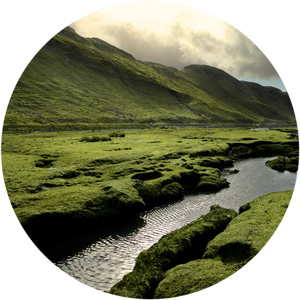
Development anywhere affects local water movement. In many upland areas, peat adds to the challenge. The protection of both water quality and peat habitat needs careful planning.
Any construction work will disturb the ground. Areas rich in peat, once disturbed, are particularly vulnerable to future erosion. This raises two risks.
- Reduction of water quality
Disturbed ground, excavations and temporary stockpiles all increase sediment which can be mobilised by runoff and precipitation. This colours the water and introduces other dissolved contaminants. Runoff carrying peat can also be acidic, increasing the leaching of contaminants. - Degradation of the peat habitat
Once disturbed, peat can dry and oxidize, which degrades the peat and makes erosion more likely. Changes to local hydrology can also result in peat drying in areas next to construction sites.
Reducing the risks
Measures to reduce the impact of development in peaty upland environments, as elsewhere, must be well-founded, practical and cost effective.
1 Take account of the risk factors in your initial design stage
Water flows downhill and faster on steep hills, it’s common sense, so build it into your thinking.
- Avoid construction near watercourses and drains if possible, as the water environment is more likely to be polluted if works are close to these.
- Plan a drainage strategy for construction and the longer term. Use robust and practical SuDS techniques, which will control site runoff rates and help prevent pollution and mobilised sediment.
- Keep ‘clean’ water clean. This is a key aspect of SuDS and can be achieved by using cut-off drains to intercept uncontaminated surface runoff and divert it around the works. During construction of a linear feature cutting across sloping ground (eg. tracks, pipelines, cable trenches) use lateral drainage ditches on the uphill slope, minimise the stretch being worked on at any one time and place any excavated soils on the downhill side.
- Use a surface-water treatment train for runoff from disturbed ground, stockpiles and excavations. This is another example of SuDS best practice and can consist of features such as swales, filter drains, check dams and settlement ponds. A train reduces sediment, flows and flow velocities from construction areas before discharge to the natural environment.
2 Develop a management plan for the construction period
Include simple measures, such as:
- Minimise exposure of soil, with careful scheduling of construction, particularly during winter.
- Use sediment control measures near watercourses, springs or drains (eg. silt fences, settlement/attenuation ponds) where natural features (eg. hollows) do not provide adequate protection.
- Site temporary stockpiles on flatter areas away from watercourses, storing them on geotextile membrane and covering with weighted heavy-duty polythene sheeting.
- Reinstate stockpiles as soon as possible.
- Pump discharges from excavations into settlement/attenuation ponds with silt fences to capture sediments before releasing to surrounding land away from watercourses.
- Ensure discharges do not re-enter excavations.
- Discharge construction runoff across open vegetated areas to allow further reduction in sediment transfer and increase infiltration of flows, do not discharge directly into existing watercourses or drainage channels.
- Use silt fencing to manage higher sediment loads at different phases of construction.
- Remember the Guidance for Pollution Prevention, which gives regulatory best practice and has been updated recently.
WHS work on uplands
Cairn Duhie Wind Farm EIA for RES
The commission
To produce the geology, hydrology and hydrogeology environmental impact assessment and supporting assessments for this 50 to 60 MW site in the Scottish Highlands.
The challenges
Tight time constraints. The application for planning permission was submitted to the Scottish Government Energy Consents and Deployment Unit just 6 months after scoping.
Objections from local residents to a previous application. There were concerns about downstream flooding and groundwater-dependent terrestrial ecosystems over a significant proportion of the site.
Keys to success
Sustainable drainage design. We developed a SuDS design statement to cover the construction and operational phases of the development. The design included appropriate, robust and practical SuDS techniques to control site runoff rates and minimise the impact of increased surface water runoff on the natural environment.
Attendance at the Public Inquiry as an expert witness during the private water supplies hearing.
Result
Approval was granted in October 2017.
Surface water management for Green Highland Renewables
The commission
Drainage design and other mitigation measures for the construction phases of run-of-river hydroelectric power schemes in Scotland. The requirement was to satisfy the Scottish Environment Protection Agency (SEPA) regarding surface water management aspects and control of water quality in particular.
Our solutions
Cost-effective methodology for a hydrological assessment to determine volumes of run-off.
Pragmatic surface-water run-off control design that could be constructed using compact construction plant. The sites were very steep, in an upland mountain environment, and access constraints restricted the nature of plant and materials that could be used during construction.
Simple, practical checklist to operate and maintain the drainage measures during construction.
Result
Approval and recognition of our methodology as best practice by the client and SEPA.
The last word
“I just want to record my thanks for your input. It was quite an intensive timescale, and everyone worked very hard to tight timescales. I think it went well and that is due to the dedicated professionalism of you all and great team working.” RES
“I think this is a really good effort. It is easy to read, concise and I’m sure just what SEPA and our client is looking for.” Green Highland Renewables